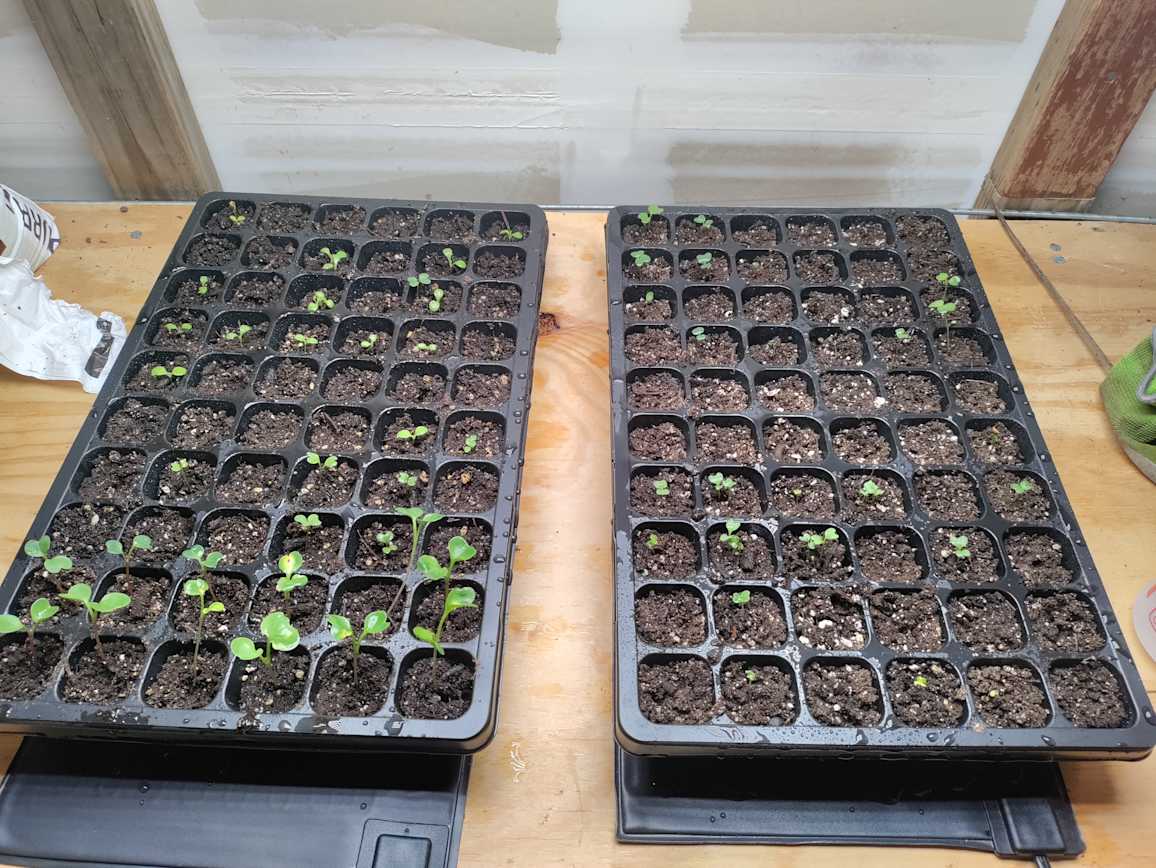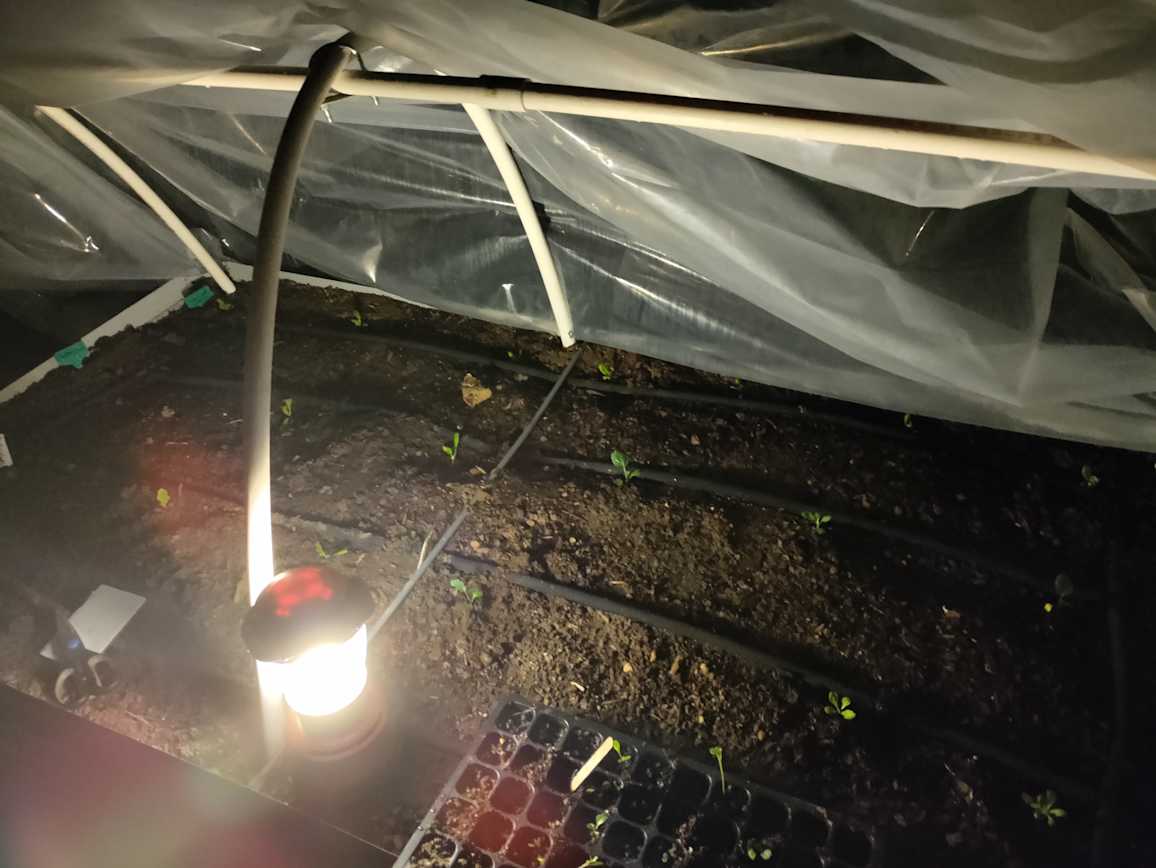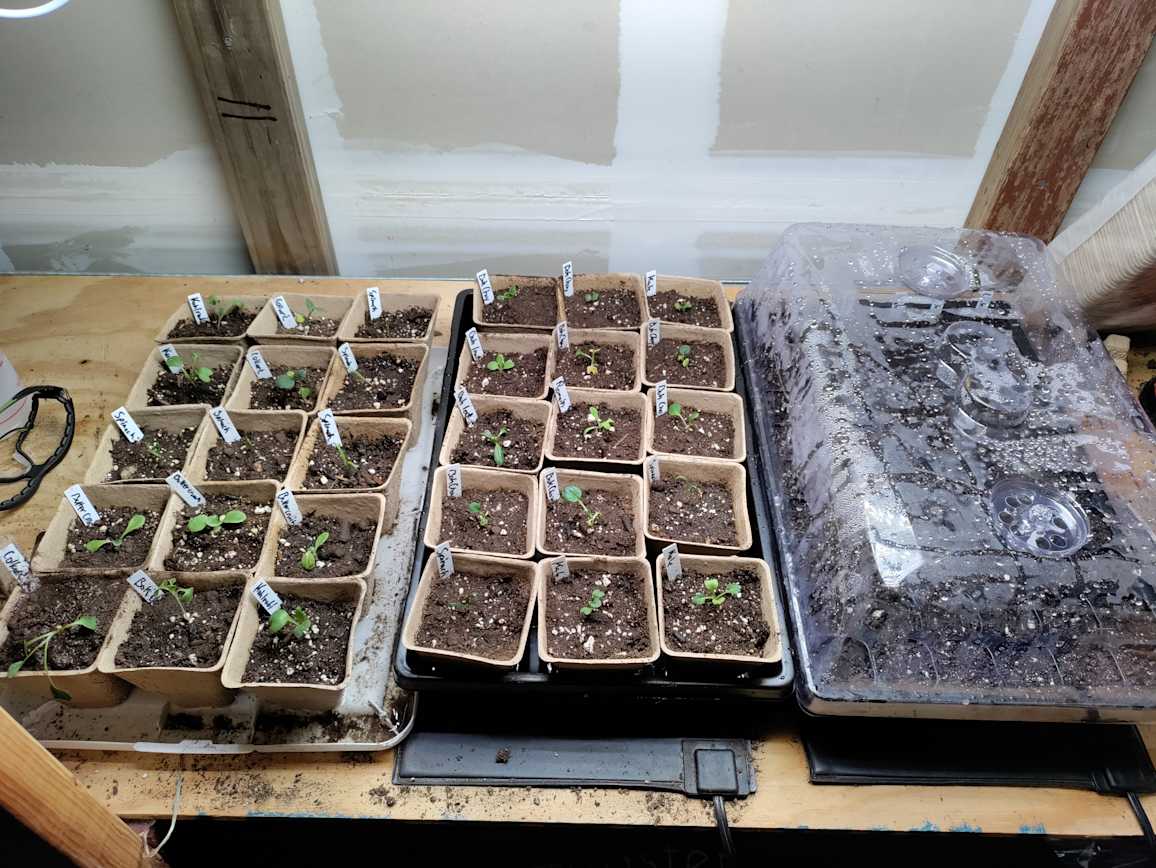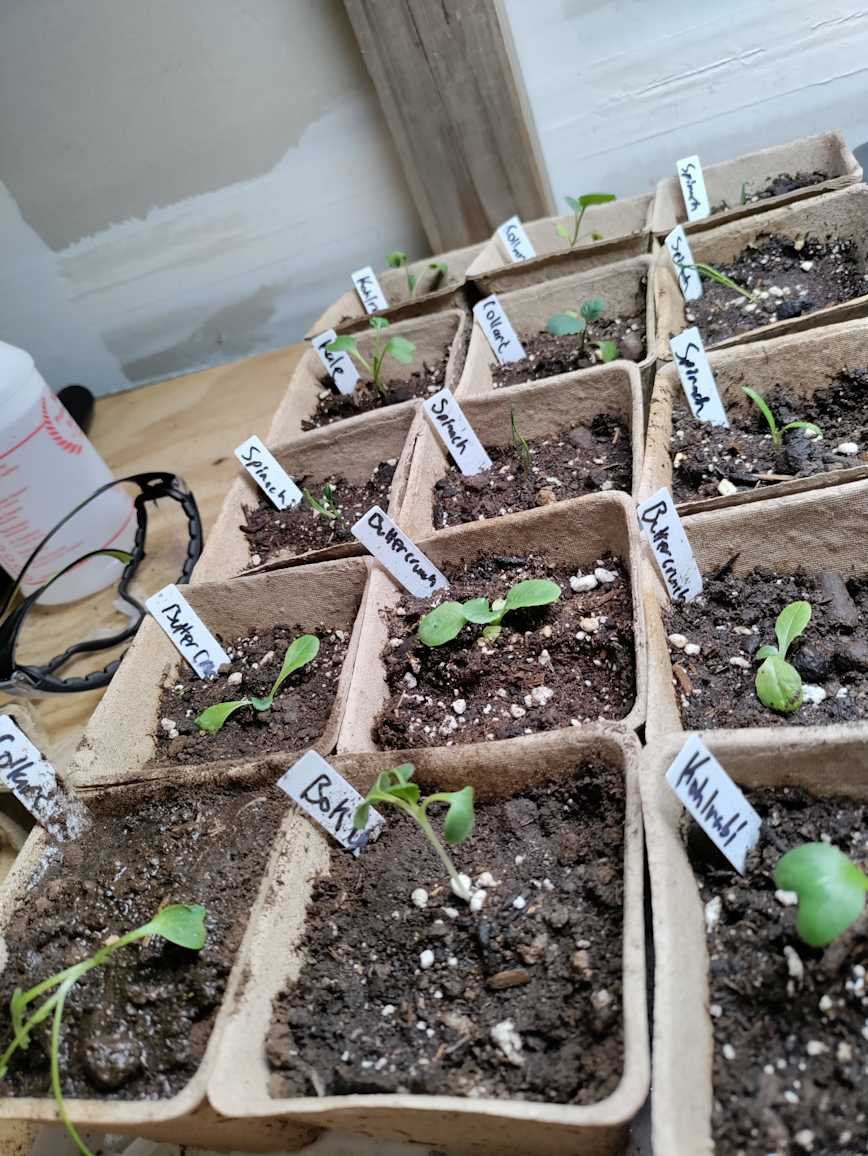I built a vegetable garden
Sat Apr 01 2023
I suppose this website did what it was intended to do: exist to put on resumes for an engineering role. I did end up leaving BigCommerce and moving to an engineering role in the IT division of a CPG company. Since my workdays are full of more technology than I could possibly need, I decided to take a break from techie side projects. So I'm doing other things with that time now, like gardening. It's been great.
Summer 2022 | The First Garden
My family moved to the suburbs in USDA zone 8b in the summer of 2021 when we finally became homeowners. The backyard is not large, and the only notable feature was a young pear tree. I've always liked growing things, so one of the first projects I completed was to create compost bins that we could use to prepare to develop a garden on our little plot of land.
In the summer of 2022 we purchased a 10-ft diameter circular green felt planter, some peat pots, seeds, and dirt. We tried starting our seedlings outdoors and ended up losing many of them in a storm. Of the few that survived long enough to be planted, only one cucumber vine thrived enough to produce. We enjoyed a few harvests before our dog chewed through the vine and killed it.
October 17, 2022 | Small Cucumbers
We manually pollinated the blossoms and were rewarded with several of these little cucumbers.

October 22, 2022 | A Cucumber Harvest
We had two or three good harvests from this vine. We made pickles and also ate the cucumbers raw.

November 6, 2022 | Little Bear Helps in the Garden
My daughter liked to feel the dirt and the leaves while I worked outside.

November 12, 2022 | The Light Bulb Cucumber
This little weirdly shaped cucumber was part of the last harvest. It tasted fine to me.

2022-2023 | The Winter Garden
Even with the rough start, once I had tasted the first cucumbers from our garden I wanted to try to grow more. Several vegetables, especially hardy leafy greens, grow well throughout the winter in this part of Texas. So, I set about expanding the garden and securing it from our vine chewing dog with a wire fence.
I purchased and assembled a corrugated metal raised bed planter, then added some rebar and 1" PVC to make a frame for a cloche. I also modified two plastic bins by adding drainage holes and cloche frames. The raised bed and containers were both modified to integrate an irrigation system. The irrigation system comprised about 25 feet of soaker hose, several stakes to hold the soaker in place, 15 feet of vinyl hose to connect the containers, a 50 foot garden hose to supply water, and several barbed hose fittings and couplings to cover the entire bed with soaker hose and to allow the system to be modular.
I used leftover firewood to fill the bottom layer of the raised bed. I combined some raised bed mix with the dirt from the previous garden and some compost from our compost bins.
In February 2023, central Texas experienced an uncharacteristically long freeze. To make matters worse, the freeze was accompanied by non stop freezing rain for days. Many tree branches were broken from their trunks under the weight of the unusual ice buildup, and gardens all around froze. But not this one! Thanks to the PVC frame, some 6 mil greenhouse film, and spring clamps, the raised bed and containers retained enough heat to keep the plants comfortable.
November 10, 2022 | The Worst Instructions Ever Written
The manufacturers of this planter had the audacity to call this single sided sheet of paper an "instruction manual".

November 16, 2022 | Seedlings
I set up a seed starting area in the garage with some LED grow lights, seed trays, and heat mats. I started several greens including:
Romaine Lettuce
Buttercrunch Lettuce
Oak Leaf Lettuce
Kohlrabi
Collard Greens
Turnips
Radishes
Spinach
Kale

November 29, 2022 | Night Planting
My new company is based in Los Angeles, so I often work on Pacific time meaning I would finish work after the sun had set. So a lot of the construction and tending took place at night. Here you can see the garden immediately after planting the largest seedlings by lantern light.

December 4, 2022 | Peat Pots and New Seeds
Some of the plants that weren't large enough to transplant earlier were beginning to outgrow their seed pots. Since they weren't quite ready to go outside yet, I put them in some larger peat pots and used one of the seed trays to start a new batch of leeks and scallions.

I will never plant spinach again. Only a few survived and they never grew large enough to care about. Spinach and I are not on good terms.

December 23-24, 2022 | Transplanting Round 2
Several seedlings in the peat pots grew strong enough to survive transplantation and the onions had sprouted. We ate the scallions shortly after this, but the leeks are still growing today.

The winter garden spent most days under the greenhouse film. Here you can see the garden with the film pulled back.

January 8, 2023 | Some Growth
I was getting ready to travel to LA for work, so I took this picture of the garden. You can see how much the Romaine grew in just a couple of weeks. This was also about the time that I sowed more lettuce and some mustard greens beneath some of the larger kohlrabi and collard greens and transplanted the last of the spinach.

January 18, 2023 | First Winter Harvest
Our radishes started plumping up nicely in January. I planted more and the family continued eating radishes all winter.

Feb 1-2, 2023 | The Hard Freeze
We'd had a few frosts and short (a few hours) freezes this winter, but nothing like what was about to happen. After the local weather forecasted an extended freeze, I added small posts around the pots and also attached greenhouse film to enclose those. During the freeze, the cloches were encased in 3/4 inch of ice. I placed mugs of warm water under the cloches. When I reached in to swap them out the next afternoon, it was actually a little warm under the cloche.
This is the part where I have to say that the cloches were my wife's idea. She also made this awesome sign for me because she's awesome. Welcome to the Gnar Gar.

The greens seemed perfectly happy with a couple warm mugs and the greenhouse film. I think we lost one turnip.

Some ice had built up around the entire cloche. It added additional insulation to the garden.

The kale and radishes did just fine, too.

February 6, 2023 | Spring Seedlings
I had started some seeds to be ready to go out after last frost. It was probably a little earlier than necessary, and some of the seedlings ended up living in peat pots for longer than I'd like. But they did quite well overall and most eventually made it outside. The little blue pot in the back is rosemary which probably won't go outside until July.

I lined the seed starting area with foil to reflect as much light as possible. My seedlings were all leggy from this batch, so I've started raising the seed trays up closer to the light.

February 18, 2023 | More Winter Harvests
We gathered a harvest like this to make fresh salads and veggie dishes with our dinners about once a week for several weeks.

February 2023 to Present (April 1, 2023) | The Spring Garden
Having had some success with the winter garden, I scaled the garden a bit by adding a new raised bed, some hanging baskets, and a table for smaller pots. In late February, I bet that we wouldn't see any more frosts even though the last frost date wasn't until early March. I put the spring garden out a little early. The gamble paid off, and I'm already starting to get some harvests from the cilantro as well as second growth off of some of the lettuces that I repotted.
The Spring garden includes:
Zucchini
Large Cherry Tomatoes
Beefsteak Tomatoes
Jalapeno Pepper
Cayenne Pepper
Anaheim Pepper
Bell Pepper
Eggplant
Strawberries
Cilantro
Basil
Sorrel
Leeks
Beets
Romaine Lettuce (repotted root crowns after harvesting)
Buttercrunch Lettuce (repotted root crowns after harvesting)
Kale (from the winter garden)
February 25, 2023 | Transplanting the Spring Garden
The cilantro and beet seedlings that I sowed outdoors earlier in February sprouted. I also transplanted the seedlings from January. The kale from the winter garden continued to grow and we started harvesting some of the lower kale leaves shortly after this.
These little cilantro seedlings have grown large enough to garnish some tacos recently.

The beets started popping up, and the leeks were taking root.

Zucchini, peppers, and tomatoes went into the original raised bed.

The kale keeps on trucking.

February 28, 2023 | Strawberries
I built a hydroponic system in my garage to grow strawberries. I had space for 18 plants in the system, and I bought 25 root crowns. So, 7 went outside in pots and hanging baskets. I've built other hydroponic systems since, but that's a story for another post.

The soil strawberries took a little longer to get started.

March 26, 2023 | Rabbit Mulch
I took these pictures several days ago. This year we've also started raising meat rabbits, so I have an abundance of rabbit poop fertilizer. We made the mistake of using hutches with shavings at first, so I ended up with way too much used bedding to compost. I added what I could to the garden as mulch and threw some more away. We switched to cages later, but the rabbit story is best saved for another post, too.

Rabbit manure is considered cold fertilizer, meaning it does not need to be composted before it's added to a garden because it will not burn the plants like hot manures.

The PVC frame will double as a structure to tie off the tomatoes. The ones that aren't close enough to the PVC get a cage or a stake.

The beets and leeks look good. Some beets may be ready to harvest in a few weeks.

The zucchini is starting to grow some powdery mildew. A weak vinegar spray solution seems to help.

The basil in the front has been doing really well. The lettuces in the back were harvested a second time shortly before this picture.

The strawberries in the hanging baskets are doing quite well. I had to start pinching blooms 3 weeks after planting the crowns.

That kale keeps on getting bigger. They will grow back for a second year, so we'll continue to harvest the lower leaves as long as we can.

Lessons Learned
Take your time and enjoy the tedious things like sowing starting trays.
It's best not to branch a soaker hose so that the pressure is more uniform throughout the hose length.
Fertilizer is important.
Good soil is more important.
You will forget to turn off your irrigation, so buy a hose timer.
A good winter garden will survive a few days in an igloo.
Bi-metal hole saws are very handy.
Food tastes better when you grow it yourself.